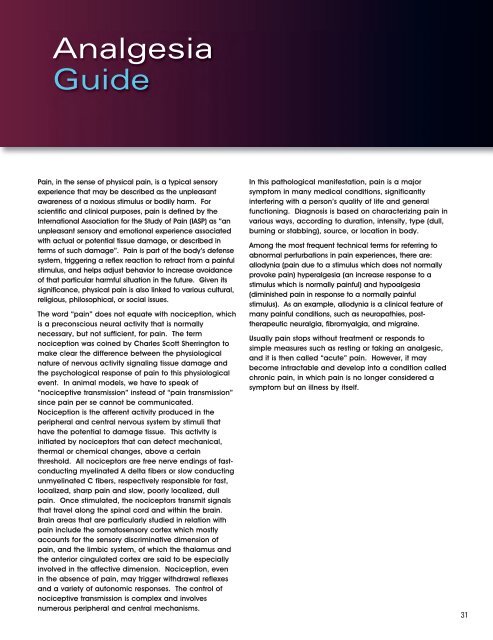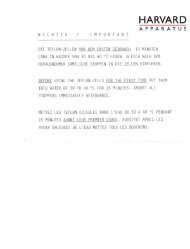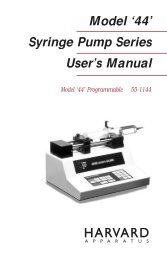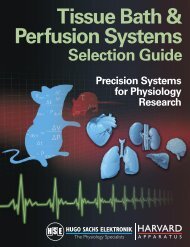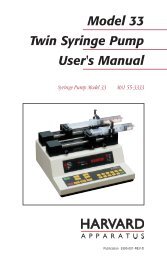View Catalog PDF - Harvard Apparatus
View Catalog PDF - Harvard Apparatus
View Catalog PDF - Harvard Apparatus
Create successful ePaper yourself
Turn your PDF publications into a flip-book with our unique Google optimized e-Paper software.
Analgesia<br />
Guide<br />
Pain, in the sense of physical pain, is a typical sensory<br />
experience that may be described as the unpleasant<br />
awareness of a noxious stimulus or bodily harm. For<br />
scientific and clinical purposes, pain is defined by the<br />
International Association for the Study of Pain (IASP) as “an<br />
unpleasant sensory and emotional experience associated<br />
with actual or potential tissue damage, or described in<br />
terms of such damage”. Pain is part of the body’s defense<br />
system, triggering a reflex reaction to retract from a painful<br />
stimulus, and helps adjust behavior to increase avoidance<br />
of that particular harmful situation in the future. Given its<br />
significance, physical pain is also linked to various cultural,<br />
religious, philosophical, or social issues.<br />
The word “pain” does not equate with nociception, which<br />
is a preconscious neural activity that is normally<br />
necessary, but not sufficient, for pain. The term<br />
nociception was coined by Charles Scott Sherrington to<br />
make clear the difference between the physiological<br />
nature of nervous activity signaling tissue damage and<br />
the psychological response of pain to this physiological<br />
event. In animal models, we have to speak of<br />
“nociceptive transmission” instead of “pain transmission”<br />
since pain per se cannot be communicated.<br />
Nociception is the afferent activity produced in the<br />
peripheral and central nervous system by stimuli that<br />
have the potential to damage tissue. This activity is<br />
initiated by nociceptors that can detect mechanical,<br />
thermal or chemical changes, above a certain<br />
threshold. All nociceptors are free nerve endings of fastconducting<br />
myelinated A delta fibers or slow conducting<br />
unmyelinated C fibers, respectively responsible for fast,<br />
localized, sharp pain and slow, poorly localized, dull<br />
pain. Once stimulated, the nociceptors transmit signals<br />
that travel along the spinal cord and within the brain.<br />
Brain areas that are particularly studied in relation with<br />
pain include the somatosensory cortex which mostly<br />
accounts for the sensory discriminative dimension of<br />
pain, and the limbic system, of which the thalamus and<br />
the anterior cingulated cortex are said to be especially<br />
involved in the affective dimension. Nociception, even<br />
in the absence of pain, may trigger withdrawal reflexes<br />
and a variety of autonomic responses. The control of<br />
nociceptive transmission is complex and involves<br />
numerous peripheral and central mechanisms.<br />
In this pathological manifestation, pain is a major<br />
symptom in many medical conditions, significantly<br />
interfering with a person’s quality of life and general<br />
functioning. Diagnosis is based on characterizing pain in<br />
various ways, according to duration, intensity, type (dull,<br />
burning or stabbing), source, or location in body.<br />
Among the most frequent technical terms for referring to<br />
abnormal perturbations in pain experiences, there are:<br />
allodynia (pain due to a stimulus which does not normally<br />
provoke pain) hyperalgesia (an increase response to a<br />
stimulus which is normally painful) and hypoalgesia<br />
(diminished pain in response to a normally painful<br />
stimulus). As an example, allodynia is a clinical feature of<br />
many painful conditions, such as neuropathies, posttherapeutic<br />
neuralgia, fibromyalgia, and migraine.<br />
Usually pain stops without treatment or responds to<br />
simple measures such as resting or taking an analgesic,<br />
and it is then called “acute” pain. However, it may<br />
become intractable and develop into a condition called<br />
chronic pain, in which pain is no longer considered a<br />
symptom but an illness by itself.<br />
31


